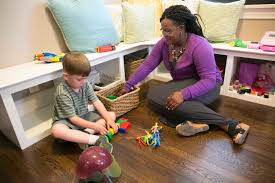Play therapy reaches kids in a developmentally appropriate way, giving them the chance to communicate in their natural language of play. While adults can access their fully developed brains to verbalize problems, stressors, and strengths, children are still growing and do not have the same capacity to speak about their hardest moments. As Play Therapist Paris Goodyear-Brown explains in one of her TEDx talks, the brain has three main regions that play different parts. The bottom region (the lower brain) is responsible for basic rhythms and energy levels (heartbeat, balance, breathing, sleeping); it asks the question, “am I safe?” The middle region is responsible for memory making and emotional processing; it asks, “am I loved?” The front-most part of our brains, right by our foreheads, cares about judgment, decision-making, and analytical thinking; it asks, “what have I learned?” (Goodyear-Brown, 2018; Van der Kolk, 2014) This part of our brain does not actually finish developing until our 20s! Children are operating more often in the lower and middle regions of their brains, and the more stressed a person is, the more they function within those first two parts. Think about the last time you were stressed—maybe someone cut you off in traffic or said something hurtful to you—were you able to immediately analyze that moment? Probably not. It may have taken time for you to be able to feel safe enough to do that, to take in the experience and understand what happened.
Is Play Therapy Effective and worth the time and effort?
The research says: yes! Four separate meta-analyses showed that play therapy for children had moderately large to large effect sizes (Golding, 2016). The research demonstrates that play therapy is as effective as most forms of psychotherapy for adults, with the advantage that it is developmentally appropriate for children. It is also helpful to understand how play therapy transforms into visible changes. When a play therapist welcomes a child into the therapy room, the play therapist offers a safe and non-judgmental space through something called unconditional positive regard. Through use of toys as words, the child builds a world that the play therapist is trained to witness, narrate, and break down. Within play therapy sessions, a child may move between what looks like more emotionally charged play and less emotionally charged play. Depending on what your child needs to work on, this process may look different and moving between types of play will be important as your child works on their specific goals in play therapy. The play therapist joins with caregivers, translating what is happening symbolically into a treatment plan that the caregivers, child, and play therapist can work on together. Through play-based activities in the play therapy room and at home, the play therapist facilitates the child’s growth process and empowers the child’s healing.
References:
- M Golding, J. (2016). Evidence-based child and adolescent psychotherapy: It’s not what you think: Evidence-based psychotherapy. Journal of Paediatrics and Child Health, 52(10), 919–922. https://doi.org/10.1111/jpc.13272
- Van der Kolk. (2014). The Body Keeps the Score. Penguin Books, New York: NY
Goodyear-Brown, Paris. (2018). https://www.youtube.com/watch?v=SbeS5iezIDA
